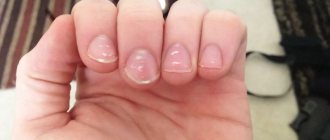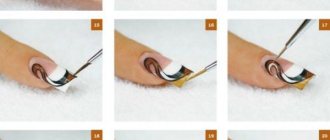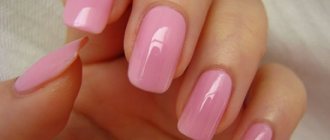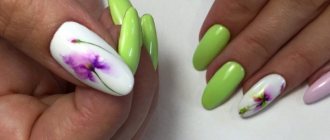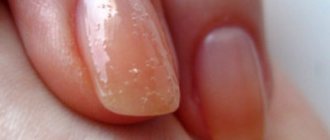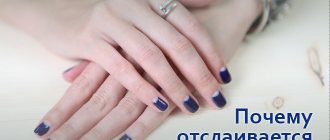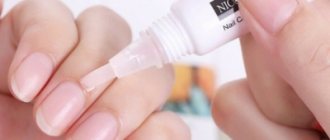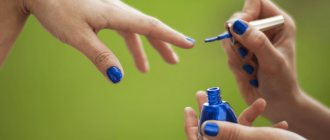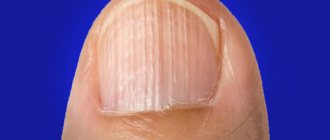The main function of nails is to protect the nerve endings located at the fingertips. But, in addition, nails are an excellent indicator of the general condition of the body. They are sensitive to all changes and malfunctions in the functioning of internal organs and signal the occurrence of pathologies in one area or another. Therefore, if the condition of your nails has changed for the worse, you should pay attention to your health.
Ideally, nails have a smooth surface, shine, and have pale pink plates with a pronounced white hole at the base. The nail bed is regularly renewed, growing approximately one millimeter per week.
Why do pits and holes appear on nails, what do they mean?
When the human body is in a balanced, healthy state, its nails should be pink, shiny and hard. Nutrition, environment, cosmetic care, physical, chemical and mechanical stress are important factors that affect the appearance of such troubles as pits on the nails. The manifestation of any health disorders is the same reason for a change in the appearance of nails, as is a change in any of the above elements in an unfavorable direction.
Transverse dents
The appearance of transverse dents on the thumbnail most likely indicate the presence of problems with the respiratory, that is, bronchopulmonary apparatus.
Holes
In cases where dots in the form of holes appear on the nails, a person wonders: what could it be? Very often, the presence of small holes and pores indicates a pathology of the spleen.
Pits
However, there is also the concept of “ thimble symptom ”, in which small dents appear on the nail - pinpoint “weariness”. The pits can be located one at a time randomly or in many “slender” longitudinal rows. The appearance of a dimple is possible both with psoriasis or dermatoses, and with systemic diseases, such as alopecia areata (the main symptom is the appearance of bald spots on the head).
Dents on nails and their causes (depending on the shape).
We will consider such serious reasons in more detail below.
Dimples
In medicine, there is a term called “thimble syndrome,” in which small dimples form on the nails. The nail seems completely pitted. They usually stand in rows or randomly scattered across the entire surface.
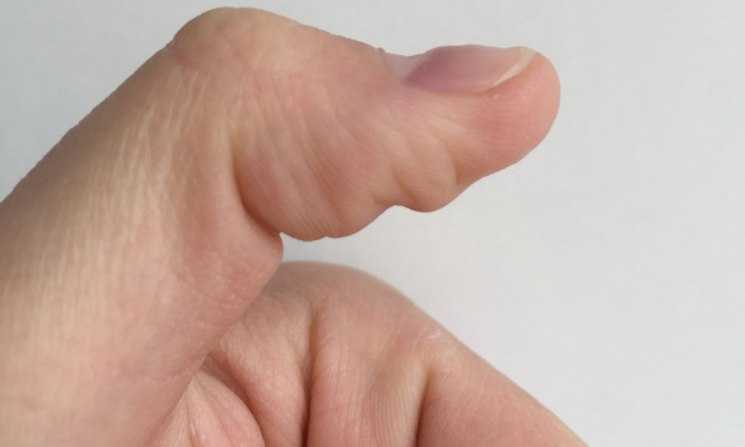
Such depressions indicate an emerging disease, such as psoriasis, dermatitis or some kind of systemic disease (if you have other symptoms, do not delay going to the doctor).
Nail self-diagnosis
You need to start diagnosing with the holes.
In the East, they believe that if a person has a missing hole on his thumb, this indicates mental problems.
The nail on the index finger signifies colon health. Its changes indicate diseases in the gynecological field.
If there is no hole on the middle finger, this means that the person may have problems with the circulatory system. With damage to the pituitary gland or neuroses of the heart, the holes may disappear. If you follow a healthy lifestyle, all the holes will return to their places, showing that your health is in perfect condition.
The nail of the ring finger indicates problems in the endocrine system.
An interesting feature is that the hole on the little finger disappears with age in some people. The nail on the little finger itself shows the condition of the heart and small intestine. Over the years it can become clogged with waste, and then the hole will simply disappear.
If your nails have small pits
, a dermatologist may suspect psoriasis (but this happens infrequently - only in 10% of those observed). But there are small holes and pores on the nails
indicate pathologies of the spleen.
Curved nails
indicate oxygen starvation, lung condition, and heart disease. In this case, a visit to the doctor and examination is mandatory. One of the signs of lupus is uneven red lines at the base of the nail. Melanoma is indicated by dark lines.
A healthy person's nails are often pink. Any deviations from the norm are a reason to check with a doctor and make sure that everything is in order with your health. If your nails are yellow and peeling
- it is possible that you have problems with your lungs. White color
indicates problems with the liver, red indicates problems with the heart.
White-pink nails
indicate possible kidney problems, while yellowish-blue nails may indicate diabetes.
If your nails are shiny
as if they were covered with clear varnish - it’s worth checking for hepatitis. Nails with a bluish tint may indicate a lack of oxygen. This leads to a huge chain of diseases, to the point where there may be fluid in the lungs.
White dots on nails
indicate that your body lacks essential vitamins. Sometimes pale color and brittleness of the nail plate are a sign of anemia, which means a lack of iron, and can also indicate problems with the metabolism of sugars in the body or drinking large amounts of alcohol.
Are your nails too red?
This may indicate that you have too many red blood cells in your blood. But pale nails, on the contrary, indicate anemia and disorders in the blood system.
If your nails are not growing well
or do not grow at all, be sure to visit an endocrinologist - these may be symptoms of problems with the thyroid gland.
Habit of biting nails
speaks of nervous system disorders, constant worries and gastritis.
A sign of bacterial endocarditis are stripes that look a little like splinters.
(actually these are small hemorrhages). Similar stripes can also appear due to trichinosis.
If your nails are brittle and brittle
, this may be the cause of a lack of minerals, hypovitaminosis and indicate your state of stress. The body signals you that it’s time to take care of yourself, relax, take a vacation and take a course of multivitamins.
The nail plate in healthy people is always smooth, but its ribbing
may indicate a wide range of diseases, for example, disorders of the cardiovascular or respiratory systems. It could also be a sign of anemia or a problem with the thyroid gland.
If you are 100% sure that you do not have any of the above diseases, but your nails still remain ribbed, it means that they lack keratin (the material from which the nail plates are made). It may also indicate a lack of vitamin B or moisture and oils.
What does the color of the lunula say?
Even from a medical point of view, a change in the color of the lunula is a rather valuable diagnostic sign:
- White color is normal. Ideally, lunulae should be just a few shades lighter than your skin tone. If the nail becomes covered with whitish spots, this indicates disturbances in the functioning of the heart muscle.
- Yellow spots indicate circulatory disorders in the brain. You should sound the alarm if yellowing of the nails is accompanied by a severe headache, dizziness or floaters in the eyes.
- Gray is an indicator of severe physical exhaustion or problems with nutrient absorption.
- A blue tint may indicate a copper metabolism disorder.
- Blue or purple color of the lunula indicates a lack of oxygen in the blood. This problem occurs in people suffering from night snoring and breathing rhythm disturbances.
- red with heart failure, liver cirrhosis and psoriasis. It is important to analyze and remember what symptoms have bothered you recently.
- Black bases of the nail can appear after a severe bruise, pinching, burn, injury, and even gas poisoning.
Fungal infections
Infection with fungi can occur in public places - saunas, swimming pools, baths. At the same time, flip-flops do not always protect against infection. To make a diagnosis, a dermatologist takes a scraping from the nail plate. The type of fungus that caused the infection is determined in the laboratory.
Most often, this problem appears on the toenails. Outwardly it looks far from aesthetically pleasing, but pain with such an infection is rare. Fungus infection is also possible on the hands.
Fungus
If all your fingernails are covered in dents, this may indicate a nail fungus infection. You could easily catch it in a shared space where your hands or feet might come into contact with wet objects.

These places are often shared showers, swimming pools, saunas and locker rooms. Even spanking cannot save you from all the dangers that await you.

To find out exactly what type of fungus has settled on your nails, you should visit a doctor and have it scraped. Laboratory testing will help the doctor make the necessary diagnosis and formulate further treatment.
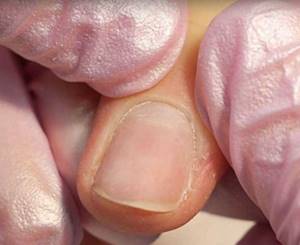
Proper nutrition
Peculiarities:

- To strengthen nail tissue, amino acids are needed; they make up the strong protein keratin. Minerals such as calcium, iron, phosphorus, silicon, chromium, selenium, zinc and sulfur are also extremely important. Sulfur atoms, for example, provide bonds between chains of keratin molecules, making nails strong and not prone to brittleness and delamination.
- To fully provide the body with nutrients, you need to include a variety of healthy foods in your diet.
- First of all, it is strictly not recommended to consume fried and fatty foods, sausages, and unhealthy sweets.
- Vegetables, fruits and herbs must be included in the menu. It is a storehouse of all kinds of vitamins and minerals.
- To prevent dehydration, adults must drink 1.5–2 liters of water per day, in addition to the rest of the liquid.
- Dairy products - cheese, cottage cheese, milk, yogurt, as well as greens - will help provide the body with calcium.
- It is recommended to eat cereals and wholemeal bread, since cereals contain a huge amount of vitamins B1, B2, B6, which are very beneficial for nails.
- Vegetable oils and nuts are sources of vitamin E, so they should be present in the diet.
- Do not neglect foods rich in omega-3 fatty acids. They are found in flaxseed oil, fatty fish, nuts and mangoes.
- To get iron and zinc into your body, it is important to regularly consume meat and offal.
- Collagen is essential for healthy nails, so you should include jelly, jellied meat and broths in your diet.
Take care of the health and hygiene of your body, and then your nails will delight you with beauty and impeccable appearance.
Dents or dimples on the nails can really scare anyone. In fact, if you have such problems, it is not necessarily bad (but not necessarily good either). There are many different reasons and factors that cause scratches and roughness to appear on smooth nail plates. Let's take a closer look at all the possible variants of this disease.
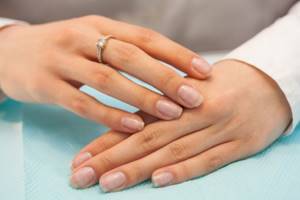
Lack of vitamins

Possible cause: vitamin deficiency! With vitamin deficiency, pits most often appear on the fingernails. However, in addition to this symptom, hair fragility or increased hair loss may be observed. The nail can “tell” which microelement is missing in the body. If the dent looks like a transverse groove and there are several of them on the plate, this indicates a lack of iron in the body.
Healthy nails
Your nails will be in good condition if you reduce their exposure to cosmetics or direct contact with household chemicals. Dishwashing liquid, washing powders and other chemicals damage your nails and skin.
Monitoring the condition of your nails is just as important as eating a balanced diet and leading a healthy lifestyle. If you still have reasons for concern, do not delay visiting a doctor. Don't miss the slightest change in the condition of your nail plates so that it doesn't develop into serious health problems.
Diagnosing dents, holes and other irregularities has been done with great accuracy since ancient times. At the same time, warning signs (for example, pits) on the nails appear long before changes in well-being and the appearance of primary symptoms of the disease; this knowledge will help us in resolving the issue of determining the causes of unevenness of the nail plates.
Care
Features of nail hygiene to maintain their health:
- Mechanical and chemical damage to the nail plates should be avoided and protected from external environmental factors. In cold weather, it is recommended to wear warm mittens or gloves. You should wear rubber gloves when working with household chemicals, soil and water.
- You need to systematically do your manicure with a high-quality and sharp instrument. It is allowed to gently, without pressing, polish the irregularities with soft one-sided movements. You should clean your nails of dirt and carefully trim uneven edges and hooks.
- It is recommended to moisturize the skin of your hands and nails. If, for example, at low air humidity the skin becomes dry, moisturizing creams and lotions should be used. To maintain the beauty and health of nails, jojoba oil mixed with an oil solution of vitamin E is used.
- It is required to follow the basic principles of proper nutrition.
Injuries, chemical exposure
Regular exposure to chemicals can lead to nail diseases such as onychochigis or onychoya, the symptoms of which can also be the nail pits. The disease leads to dystrophic changes in the body, in particular, to the splitting of the nail plate into transverse elements in the form of small leaf-shaped plates.
The reasons mainly lie in the exposure of nails to chemicals during the performance of professional duties. The disease is common among chemical industry workers and medical workers who come into contact with disinfectant solutions. However, excessive use of varnishes together with products containing acetone for its removal sometimes leads to the development of this health disorder.
The constant use of detergents and disinfectants in household use only aggravates this process.
Onychoschisis is also a disease that develops due to constant mechanical stress on the nail plate. Recently, IT workers are susceptible to this disease because they constantly type a large amount of information manually. So frequent communication via a computer may not be a harmless activity.
Causes of curvature of the nail plate
Healthy nails have a smooth, shiny, soft pink surface. If the nail plate becomes rough, growths or pits appear on it, the nail turns yellow, splits and breaks, all this may indicate diseases in the body.
The causes of curvature of the nail plate can be:
- Diseases of internal organs.
- Injury due to negligence.
- Low hemoglobin levels and the development of anemia.
- Strong medications (antibiotics) or a course of chemotherapy.
- Genetic pathologies that lead to dystrophy of the nail surfaces.
- Infectious diseases caused by fungi and bacteria.
- Psoriasis.
- Poor quality and uncomfortable shoes.
The first reason for the curvature of the nail plate is improper care. Untimely removal of dirt from under the nails or fanatical cleaning of them leads to damage to the skin of the fingers and the proliferation of bacteria, which results in the development of nail diseases.
Using household chemicals without protective equipment leads to deformation of the nail plate, since detergents and cleaning compounds can destroy its structure.
Fungal infections
Fungal infections are the most common and hold the lead among the causes that cause curvature of the nail plate on the fingers. When the first signs of nail fungus appear, it is necessary to urgently consult a specialist and receive qualified treatment, since self-therapy does not give effective results and often leads to the development and spread of the disease. It should be noted that curvature of the nail plate is not a sign of fungal infection.
The fungus not only causes deformation of the nail plate, but also provokes the formation of growths and thickenings on it. The surface of the nail becomes loose, flakes and peels, and as the disease progresses it turns yellow or black, and in advanced cases an unpleasant odor appears.
The development of pathology in the initial stages may be accompanied by peeling and redness of the skin around the infected nail. With early diagnosis, treatment is most effective, so curvature of the nail plate may not occur. From this it follows that nail deformation is a consequence of the long-term development of a fungal disease.
Injury
Mechanical damage can lead to curvature of the nail plate.
Trauma, cuts or other mechanical impacts cause deformation of the nail plate. Severe damage to the matrix and lunula can lead to peeling of the nail. Such injuries cause acute pain, and in some cases require the help of a surgeon. Injury to the nail plate on the hands can occur even during the process of performing a manicure due to incorrect and careless actions.
Psoriasis of the nail plate
One of the reasons for the curvature of the nail plate on the hands can be psoriasis. With this disease, the patient experiences nail detachment, discoloration, and damage to the surrounding skin. If psoriasis affects the toenails, then suppuration and thickening of the nail plates often form, and a characteristic striped pattern appears on their surface.
Onychotillomania
Onychotillomania is a mental disorder that is expressed in a person’s conscious desire to independently destroy the nail plate. This disease is often diagnosed in people with a psychopathic personality. With onychotillomania, a person is overcome by delusional ideas, as a result of which he injures his nails mechanically, trying to eliminate the microbes that are under them. To treat this type of curvature of the nail plate, you should seek help from a psychiatrist or psychotherapist.
Recommended articles on the topic:
- Medical hardware pedicure
- How to strengthen peeling nails
- Removing an ingrown toenail and how to avoid it
Treatment
If dents appear on the nail plates, it is strongly recommended to find out from your doctor the cause of their occurrence . A competent specialist will select a treatment that will smooth the surface of the nails and improve their appearance.
Eliminating unevenness in the nail plate will not be difficult if you plan your diet correctly, as well as understand the cause of their occurrence and follow the prescribed treatment.
Successful treatment of the underlying disease allows you to eliminate uneven nails completely:
- if fungus or psoriasis is present, the help of a dermatologist is required;
- if lung diseases are detected, you need to consult a pulmonologist;
- patients with heart pathologies are treated by a cardiologist;
- If there is a lack of vitamins in the body, you should consult a therapist, who will prescribe medications and adjust the patient’s diet.
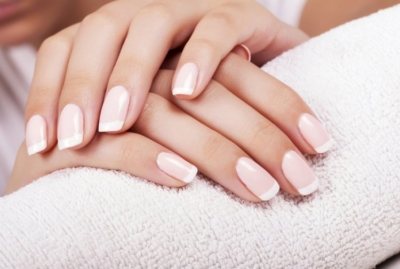
To reduce the depressions on your nails, experts recommend using polishing files. The tool should be moved only in one direction, do not press too hard, movements should be neat and soft. To smooth the surface of the nail and make the dimples almost invisible, several polishing procedures should be performed.
Diagnosis of curvature of the nail plate

When you identify the first symptoms of curvature of the nail plate, you must consult a doctor for a diagnosis. You should consult a mycologist or podologist. If this is not possible, then consult a dermatologist. Often, during the initial examination, the doctor can determine the disease based on the appearance of the affected nail plate. However, for a complete diagnosis, the patient must undergo the following procedures:
- microscopic examination of the affected area;
- spectral analysis;
- blood diagnostics for the amount of vitamins contained.
Nail psoriasis
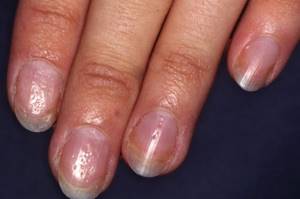
Pits on the fingernails (with psoriasis).
In patients with this disease, only the nails are rarely affected. Usually other parts of the body are also affected - very often the skin, sometimes the bones.
Symptoms can be different, the main ones are:
- the color of the nails becomes yellow with brown tints;
- holes (small depressions) appear on the nail plate;
- horizontal lines (transverse dents) and white spots appear on the fingernails;
- plate thickenings form;
- the nail plate may separate from the bed.
Many patients are interested in how to get rid of psoriasis. The answer is clear - it is impossible. However, it is possible to cope with the symptoms with the help of ointments and injections, which the doctor can select (individually for you).
What to do, how to treat
Symptoms consisting of the appearance of various dents, grooves, pits and depressions on the nails are possible due to completely different reasons. Some require only a little effort to heal, while others may take the rest of your life to heal:
- Infections. To prevent fungal diseases, baths with the addition of lemon juice or vinegar are used. Treatment of fungal infections is not a quick matter, since the penetration of drugs in the form of ointments through the nail plate takes a long time. Comprehensive treatment, including tablets, ointments and vitamins, brings the greatest effect. ⇒ For more details, see the articles about antifungal varnish, tablets for nail and skin fungus, iodine against nail fungus.
- Vitamin deficiency can be compensated for by taking vitamin complexes orally and restoring a balanced healthy diet. It is necessary to have less contact with detergents and washing powders. The most effective methods of nail restoration can only be found together with your doctor.
- The chemical effect on the nail plate can only be restored with complex treatment. It is necessary to restore minerals and vitamins in the body. Vitamin injections and tablets are also prescribed.
- Nail psoriasis. For this disease, treatment is carried out using traditional therapy or phototherapy, and surgery is also possible to remove deformed nail plates. Instead of the latter, medications with urea compounds can be used, which allow the nail to separate from the bed without surgery. The drugs used can be either external use, directly applied to the nail, or internal or in the form of injections. A defect in the nail plate can hide a manicure.
Cosmetic procedures
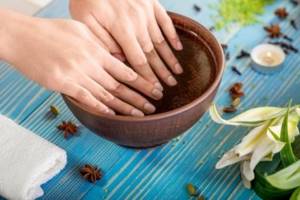
You can go to a beauty salon, where specialists will remove your cosmetic defect with special tools and preparations.
During the treatment of the defect, you should stop using decorative coatings of any composition and nail extensions.
- Baths with the addition of sea salt . Add 1 teaspoon of sea salt per liter of hot water. Nails are soaked in this solution for 10–15 minutes.
- A decoction of oak bark and chamomile . Take 1 tbsp. spoon of vegetable mixture, pour 1 liter of boiling water. Soak your hands in this bath for microdamages for 12–17 minutes.
- Massage with vitamin A and E. Puncture the capsule with vitamins daily and rub their contents into the nail plates.
- Olive oil and lemon juice . Mix the ingredients in equal proportions and heat them slightly. Rub the resulting mixture into the nail plates twice or thrice a week.
What causes dents?
There can be many reasons for the appearance of dents on nails - from ordinary damage on a hard surface to a serious systemic disease that needs to be treated urgently.

Most people develop dents due to mineral deficiencies.
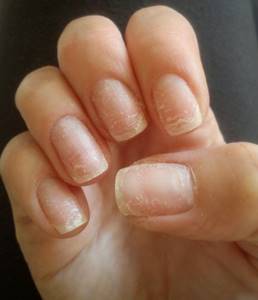
This problem can be easily solved by simply changing your diet to one richer in nutrients, minerals and vitamins. You also need to take care of your hands.
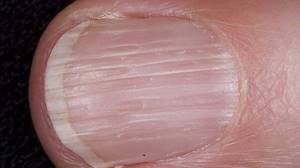
If after changing your diet the problem does not disappear, the problem is different. Rough nails indicate that you need urgent medical consultation.
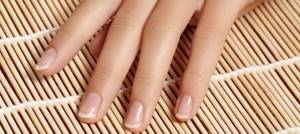
Mechanical and chemical damage
The safest and most obvious way for extraneous cuts or indentations to appear on your nails is a simple mechanical impact.

Everyone has hit hard objects at least once in their life, after which they received a minor injury. If you don't remember how you got this dent, don't worry when your nail grows to the desired length - just cut off the bump and it will never bother you again.
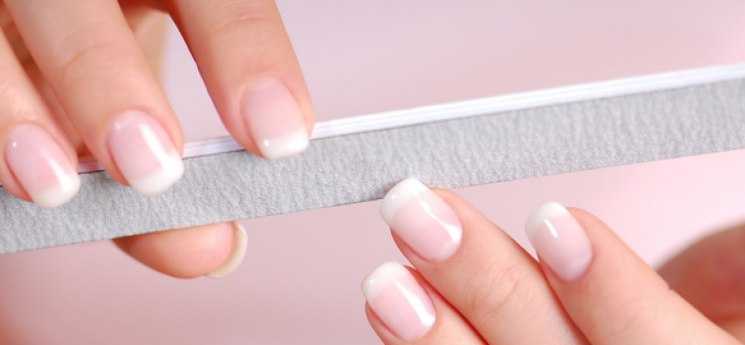
This can also happen with chemicals that, when in contact with the nail, can negatively affect it.
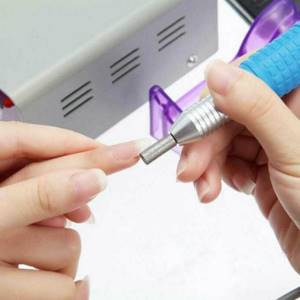
If your hands are regularly exposed to any chemicals, it may result in a serious condition that will need to be treated.
We recommend reading:
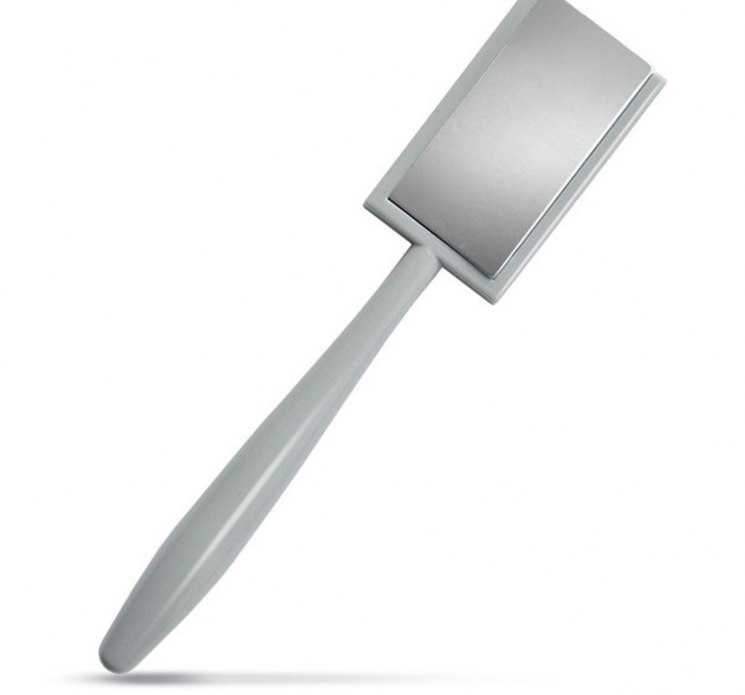
Magnet for a cat's eye: tips on how to apply iridescence simply and beautifully with your own hands (110 photos + video)
Manicure machine - tips on choosing the best models from professionals. Tips for choosing a device and manufacturer (95 photos)

How to strengthen nails - a review of effective methods and means for strengthening long and short nails (145 photos + video description)

Such diseases lead to weakening of the entire body, causing the nail plates to suffer. Then a dent may appear on your thumb.
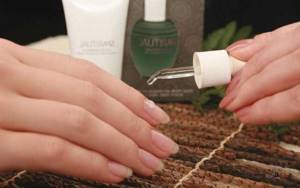
More often, professionals who constantly deal with hazardous chemicals are susceptible to such diseases.
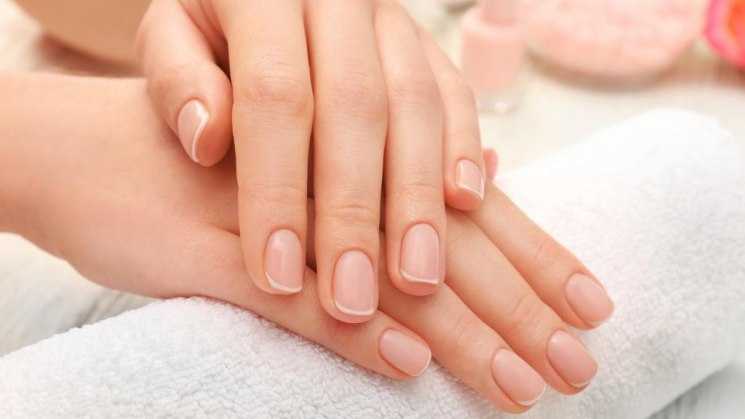
These are medical workers, laboratory technicians and cleaners who work without gloves. Remember to use protection to prevent this disease.


